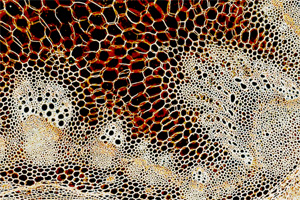
This article gives you an overview of different types of microscope objectives, but I must note that a particular objective can fall into several categories at the same time. For educational work, parfocal, achromatic, bright field objectives are very common.
Objectives can be classified as follows:
- Parfocal objectives: Parfocal optics allows for a change in magnification without much refocusing. Make sure that the objectives are designed to work with each other in this respect.
- Achromatic objectives: These are the most common and also the cheapest objectives. Chromatic aberration is corrected for two colors. When observing specimens of high contrast it is possible to see red and blue fringes. Achromatic objectives are perfectly sufficient for routine analysis and for educational purposes. They do not, however, possess the resolving power of the better corrected objectives. Some achromatic objectives also display a slight image distortion. Both chromatic aberration and distortion may be annoying when conducting photographic work, but do otherwise not disturb. Achromatic objectives do have other advantages that make them suitable for course work. They have a larger depth of field and the working-distance (the distance between the objective and the specimen) is larger as well. This makes focusing easier and reduces the chance of crashing the objective into the specimen.
- Apochrmatic objectives: These objectives are corrected for three colors. Fringes are not visible and the obtainable resolution is higher. The trade-off is a reduced working distance and smaller depth of field. These factors and a higher price make apochromatic objectives less suitable for course work.
- Plan objectives: These objectives are available for both achromatic and apochromatic versions. They contain additional lens elements that correct the distortions. The cost of these objectives is naturally higher. They are commonly used for photomicrographic work. Especially the planapochomatic objectives deliver images with no recognizable chromatic aberration and distortion.
- Fluorite objectives: Fluorite objections are composed of relatively few lens elements. For this reason the contrast is higher. These objectoves are applied in special areas such as fluorescence microscopy or fine structure research.
- Phase contrast objectives: The phase contrast technique allows for visualization of transparent and uncolored specimens. Unstained bacteria, for example, are very difficult to see using the bright-field technique, but are clearly visible in phase contrast. Phase contrast requires special objectives, however. Phase contrast objectives are available also as achromatic, apochomatic, and plan versions. The microscope itself must also be equipped with an appropriate filter system to use this technique. Phase contrast objectives can also be used for bright field work, but the image quality is lower. Due to the higher cost of phase contrast equipment I recommend that only one or 2 teacher’s microscopes are equipped with this system. These microscopes can then be coupled to a video system for the whole class to see. Before the purchase of the system, the teachers should clearly specify the type of observations that are to be conducted. If much living material is to be investigated – material that can not be easily stained – then phase contrast is preferable. If students are to conduct sample preparation and staining, then bright-field objectives are probably the better option.
- Oil Immersion Objectives: These objectives are commonly used for magnifications around 100x. A drop of immersion oil is placed on the slide and the objective is rotated directly into the oil. Immersion objectives increase the numeric aperture and thus the resolution. They are useful structures inside a cell, such as the chromosomes of dividing cells. In a school setting, oil immersion objectives are a mixed blessing. While they do allow the observation of various sub-cellular structures, significant drawbacks should not be overlooked. It can happen that students confuse the objectives and rotate non-immersion objectives into the oil. If not properly cleaned (a common problem when there is not enough time for clean up at the end of a lesson), then dust will accumulate on the objective lens delivering a blurry image in future session. Students may also attempt to use a high power oil objective without oil. In this case parfocality is not guaranteed anymore and there is the danger that the objecitve is crashed into the specimen. If oil immersion is used, then only synthetic oil should be used. Natural oils may have the tendency to solidify if not cleaned properly.
- Water immersion objectives: These are not commonly used in school educational settings. They increase resolution by immersing the objective into water and not synthetic oil.





